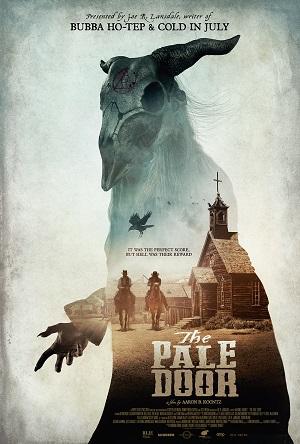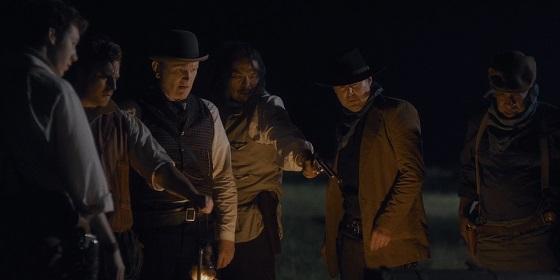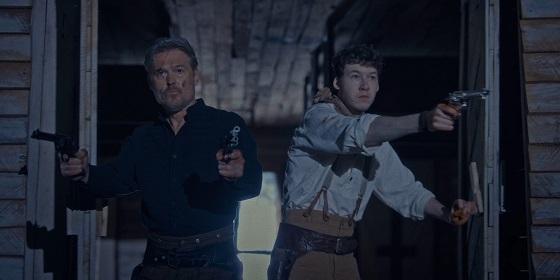

[Rating: Solid Rock Fist Up]
Opening in theaters and VOD / Digital on August 21.
A genre-bending romp through the old west that mixes cowboys with cauldrons, The Pale Door is a lot of things, but pensive ain’t one of them. A confident, deliberate, blood-spattered love letter to westerns and gothic horror alike, the new film by director Aaron B. Koontz discards any pretense of the gritty realism so popular in the post-Unforgiven/Deadwood era, leaning instead into the glossy, romantic aesthetics of its genre partner. This proportional balance between gothic and western makes for a unique and entertaining cinematic hybrid, helping it to pull off one hell of a difficult trick: encouraging the audience to care for characters on both sides of the slaughter.
The Pale Door establishes its two leads in an opening flashback scene, where teenager Duncan (Zachary Knighton) protects his younger brother Jake (Devin Druid) from masked villains attacking their burning farm. From here the film jumps ahead about a decade to an unspecific western town where Jake, now grown up, sweeps floors in a saloon Duncan and his outlaw gang visit regularly. An unexpected quickdraw duel leaves Duncan and his crew one body short for an upcoming train job, and Jake, eager to prove his worth, convinces his older and still very protective brother that he’s up for his first caper. Things go to pieces about halfway through the robbery when a Pinkerton agent guarding the locomotive is cornered and quietly freed by a nervous Jake, who looks on in horror when that same agent returns and wounds Duncan.
That’s not the only thing that goes wrong, however. Instead of a chest full of cash and gold, Duncan’s crew finds a bound and gagged young woman, Pearl (Natasha Bassett), who promises a handsome reward if she’s taken back to her town. Pearl also offers up the services of a surgeon for Duncan if they return her, sealing the deal for the gang as they head off into the night with the mysterious lady. Once Duncan, Jake, and the rest of their crew get to Pearl’s town, they learn that she is part of a coven of witches who just happen to be in need of a few key sacrifices to keep their magic going: much to the chagrin of the cowboys.

It’s a straightforward set-up, and Koontz and the script he co-wrote with Cameron Burns and Keith Lansdale move briskly through the exposition portions to get the audience into the action-packed second act. At first it seems like there’s too many characters, what with Duncan’s gang numbering about 8, yet like any good horror flick, sacrifices are made to elevate the stakes. Once the heard is thinned a bit via some old-fashioned monster gore, The Pale Door settles into a good rhythm, finding the perfect proportion of characters and archetypes to take this one to the finish line.
The standout amongst the reduced group is Bill Sage as Dodd, the mean-spirited, cruel, deadly pessimist that a person would only want on their side in the event that they’re up against a coven of witches turbo-charged with bloodlust and devil-frenzy. Koontz does a damn fine job setting up Dodd, Jake, and the rest for their admittedly expected roles in the story, sprinkling in just enough character development for those that will survive long enough to make good use of it. This isn’t just a one-sided affair, either, with a short but effective flashback thrown in to establish just what the witches want, and why.
This is important, too, for these characters are all “bad guys” in the sense that they all kill and/or steal, yet The Pale Door isn’t just a showcase for outstanding gore effects and pulse-pounding action, but a legitimate story about reconciling one’s past, and what it means to stand against society and its hypocrisies. Koontz and the script use fire as a unifying visual and thematic bridge between Jake and the witches, and while they stand on opposite sides of the conflict, their history and future, forged as it is in flames, unites them.

As a production, The Pale Door seems somewhat glossy and clean at first glance, yet the set design and costuming seem to represent a deliberate choice to make this all somewhat dreamlike, or even fairy tale-esque. Everyone’s clothes are clean, and all the sets look thoroughly dusted and swept; indeed, it’s like a Star Trek holosuite program come to life! The title of the film is drawn from an Edgar Allan Poe quote, so it’s more likely that this is just a marriage of clean, gothic aesthetics with a Wild West twist.
One area where this one does stumble is in the dialogue, which isn’t remotely period appropriate with lines like, “Oh, come on, man,” or, “What the fuck, man?” This isn’t to say that the script has to mimic the effuse, Victorian nonsense David Milch popularized in Deadwood, but finding some kind of middle ground between surfer-casual and baroque would have benefited the picture. The acting can be a bit hit and miss at times as well, with some of the dead-meat characters standing in stark opposition to the more experienced 3rd act stalwarts like Sage, who plays well off of industry mainstay Stan Shaw as Lester, the kind-hearted surrogate father figure for Jake and Duncan.
This is a small movie with modest ambitions, however, and Koontz and company seem to have made the wise decision to put their limited resources into the make-up, special FX, and set design instead of hiring out of the Steppenwolf or Broadway stables. A well-paced, creative, confident, effective horror-suspense thriller with a solid thematic foundation and proper villainy, The Pale Door is one worth opening and walking through.





Comments on this entry are closed.